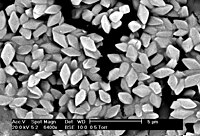
Photo from wikipedia
BACKGROUND The fall armyworm Spodoptera frugiperda and cotton bollworm Helicoverpa armigera are major insect pests of corn and cotton worldwide. Genetically engineered crops producing Vip3Aa, a potent endotoxin, from the… Click to show full abstract
BACKGROUND The fall armyworm Spodoptera frugiperda and cotton bollworm Helicoverpa armigera are major insect pests of corn and cotton worldwide. Genetically engineered crops producing Vip3Aa, a potent endotoxin, from the bacterium Bacillus thuringiensis (Bt) are effective in controlling these two harmful pests. However, Vip3Aa efficacy is relatively weak compared to that of other Bt proteins such as Cry1A and Cry1F. This study sought to modify Vip3Aa for increased insecticidal activity and determine the cause of elevated activity. RESULTS The two triple Vip3Aa mutants in domains IV and V (Vip3Aa-S543N/I544L/E627A and Vip3Aa-S543N/I544L/S686R) exhibited 8-fold and 2.6-fold increased toxicity against S. frugiperda, respectively compared with the wild type while the toxicity of Vip3Aa-S543N/I544L/S686R was 3.2 times that of wild-type protein in H. armigera. The mutants had enhanced stability in midgut juice and 2.6 to 5.1 times higher binding affinity against S. frugiperda and H. armigera compared with wild type protein. CONCLUSIONS The enhanced toxicity of Vip3Aa mutants was due to increased stability and binding affinity during infection. The amino acids S543 and I544 combined with E627 or S686 in domains IV and V of Vip3Aa are important for maintaining structural stability and receptor binding. The results match insecticidal activity (LC50 ) with binding activity (Kd ) which provides novel clues for the rational design of Bt insecticidal proteins.
Journal Title: Pest management science
Year Published: 2022
Link to full text (if available)
Share on Social Media: Sign Up to like & get
recommendations!